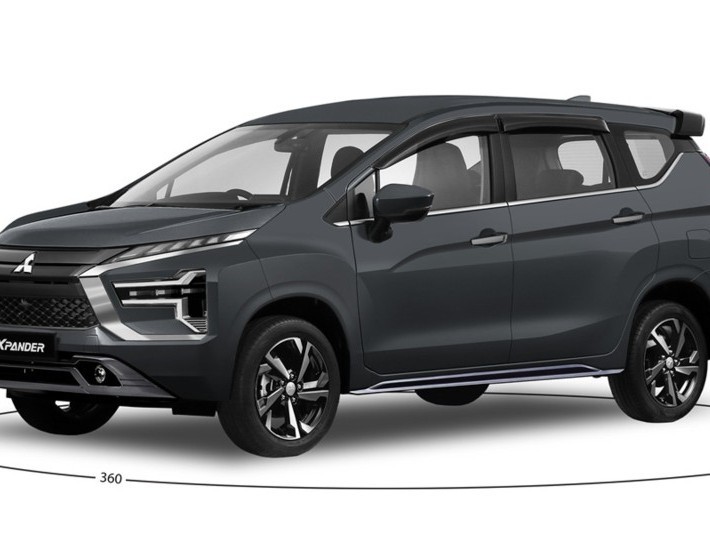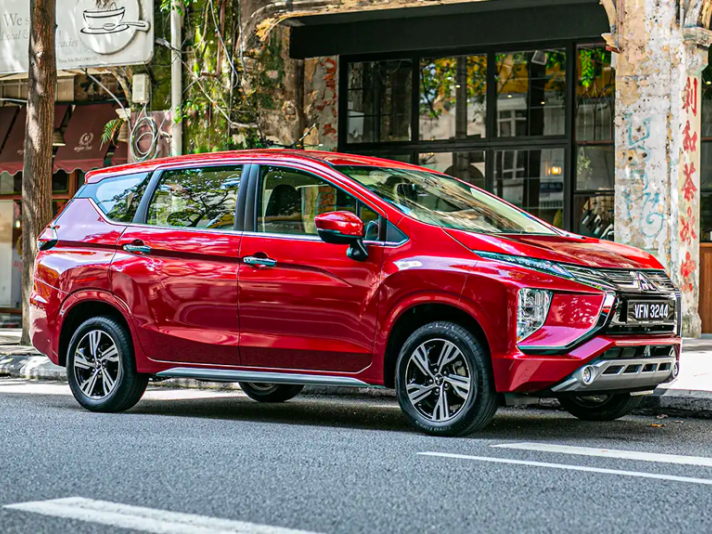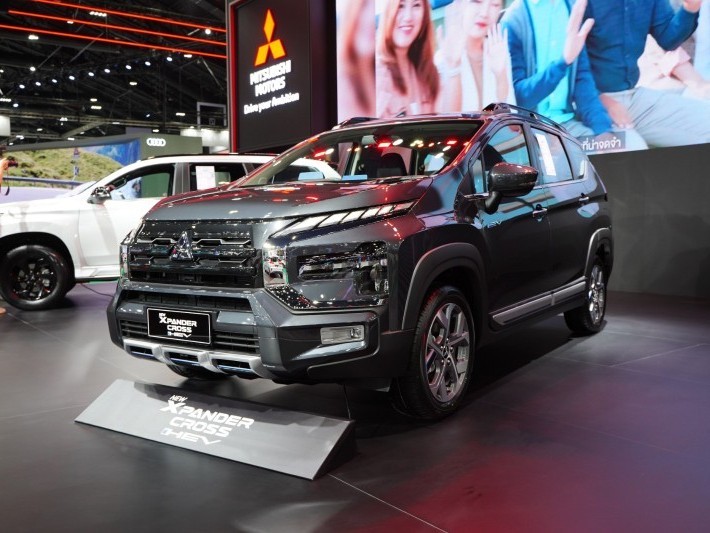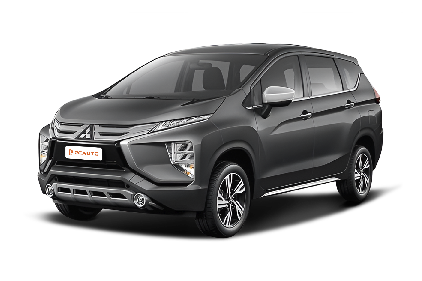Q
How many seaters is Xpander 2024?
The 2024 Mitsubishi Xpander is a highly popular 7-seater MPV model in the Malaysian market. It features a 2+3+2 seating layout, which is suitable for family users or scenarios where multiple passengers need to be accommodated. The second-row seats can be adjusted by sliding forward and backward to enhance flexibility, while the third-row seats are suitable for short trips or for children.
This model continues the practical design of the Xpander series, such as a relatively high ground clearance (205mm) and a compact body size, which takes into account both urban driving and mild off-road performance. In terms of power, it is equipped with a 1.5L MIVEC naturally aspirated gasoline engine (105PS/141Nm), paired with a 4AT or 5MT transmission, focusing on fuel economy.
It's worth noting that competing models in the same class, such as the Toyota Avanza/Perodua Alza, also adopt a 7-seater layout. However, the Xpander differentiates itself with its more angular exterior design and Mitsubishi's Dynamic Shield front - end styling. The basic trunk volume is 185L, which can be expanded to 1600L when the third - row seats are folded, meeting the multi - purpose needs of Malaysian users.
It is recommended that you visit an authorized showroom to experience the third - row space in person before purchasing a car. In particular, you need to consider the comfort of adult long - distance travel. At the same time, you can compare the configurations and prices of competing models in the same class, such as the Honda BR - V or Nissan Livina.
Special Disclaimer: This content is published by users and does not represent the views or position of PCauto.
Related Q&A
Q
Is Xpander 2024 3 cylinder?
Based on the current information, the 2024 Mitsubishi Xpander available in the Malaysian market is equipped with a 1.5 - liter MIVEC four - cylinder naturally aspirated engine, not a three - cylinder configuration. This engine delivers 105 horsepower and 141 Nm of torque, paired with either a 5 - speed manual or a 4 - speed automatic transmission. It focuses on providing smoothness and fuel efficiency for the family car market.
The doubts about a three - cylinder engine might stem from the fact that some brands have adopted three - cylinder technology in recent years for emission reduction purposes. However, the Xpander maintains a four - cylinder layout to ensure power stability. It's worth noting that although three - cylinder engines are smaller in size and more fuel - efficient, they usually require more advanced technical tuning for vibration suppression and high - speed performance. In contrast, the four - cylinder structure still has advantages in terms of durability and smoothness.
Malaysian consumers can make their choices according to their own needs when purchasing. If they prioritize low fuel consumption and are open to new technologies, they can look into three - cylinder models from other brands. If they prefer a more mature powertrain, the four - cylinder configuration of the Xpander remains a reliable option. It is recommended to take test drives to experience the differences.
Q
What is the ground clearance of the Xpander 2024?
The 2024 Mitsubishi Xpander has a ground clearance of 205 millimeters. This figure is relatively high among compact MPVs and allows the vehicle to adapt well to Malaysia's diverse road conditions, including urban roads and the rough terrains in the suburbs. The high ground clearance not only improves the vehicle's passability but also reduces the risk of chassis scratches, especially on flooded roads that may occur during the rainy season in Malaysia.
In addition to the ground clearance, the 2024 Xpander is also equipped with an optimized suspension system, which further enhances driving stability and comfort. For Malaysian consumers, this type of high - chassis MPV is very practical. It can meet the needs of family outings and handle complex road conditions.
If you often need to carry passengers or cargo and also pay attention to the vehicle's passability, the 2024 Xpander would be a great choice. Its space performance and practicality are also worth noting.
Q
Is the 2024 Mitsubishi Xpander a MPV or SUV?
The 2024 Mitsubishi Xpander falls into the MPV (Multi-Purpose Vehicle) category rather than the SUV (Sport Utility Vehicle) category. Its original design aim was to meet the needs of family users for spacious interiors and comfortable riding experiences. It features a three - row seat layout and sliding side doors, which are typical characteristics of MPVs. The Xpander has a relatively high ground clearance and crossover - style exterior kits, making it look somewhat like an SUV. However, in essence, it remains an MPV focused on practicality and versatility.
For consumers in Malaysia, the Xpander is an excellent family vehicle. It offers good comfort and convenience, whether for city driving or long - distance trips. The main differences between MPVs and SUVs lie in their body structures and uses. MPVs prioritize passenger space and cargo - loading flexibility, while SUVs emphasize off - road performance and driving visibility. Consumers can choose the appropriate model based on their actual needs.
The Xpander has always been very popular in the Malaysian market because it combines practicality, economy, and reliability, making it a great fit for local road conditions and family - use scenarios.
Q
What is the fuel consumption of the 2024 Mitsubishi Xpander?
The 2024 Mitsubishi Xpander offers a moderate fuel economy. According to official data, its combined fuel consumption is approximately 6.5 to 7.2 liters per 100 kilometers. The exact figure may vary slightly depending on driving habits, road conditions, and vehicle configurations (such as the 2WD or 4WD versions). This model is equipped with a 1.5-liter MIVEC naturally aspirated engine, paired with a 4-speed automatic or 5-speed manual transmission. The power is tuned to meet the practical needs of families.
For Malaysian users, the Xpander's fuel consumption is suitable for daily city commuting and medium - to short - distance trips, especially considering the common traffic congestion in the local area. It is recommended to perform regular maintenance (such as replacing the air filter and spark plugs) to optimize fuel efficiency. In addition, if you want to further reduce fuel consumption, you can try some fuel - saving driving techniques like smooth acceleration and reducing idling time.
Similar models in the same class, such as the Toyota Avanza or Honda BR - V, have a comparable fuel economy. However, the Xpander has an edge in terms of space flexibility and cost - effectiveness, making it a great choice for family users who value practicality.
Q
How to open the hood of Xpander 2024?
To open the hood of the 2024 Mitsubishi Xpander, first, sit in the driver's seat. Locate a handle with a hood icon near the driver's side foot area. Usually, it's located at the lower - left of the steering wheel or on the side of the dashboard. Pull this handle firmly, and you'll hear the sound of the first hood lock releasing. Then, walk to the front of the vehicle, reach your hand into the gap in the center of the front edge of the hood, and you can feel a lever for the secondary safety lock. Push the lever to the right and gently lift the hood to fully open it. It's recommended to ensure the vehicle is turned off and parked on a flat surface during the operation for safety.
It's worth noting that the hood opening methods of Xpander models from different years may vary slightly. The 2024 model uses a double - lock mechanism to prevent the hood from popping open accidentally while driving, which is also the standard safety design for most new cars nowadays. If you have difficulty opening the hood, don't force it. Check if both locks are fully released. Regularly applying lubricant to the lock parts can also keep the mechanism running smoothly. Understanding these details can help car owners better perform basic maintenance tasks such as checking the engine oil and coolant in daily life.
Q
What is the safety rating of the Mitsubishi Xpander 2024?
As of 2024, the safety rating of the Mitsubishi Xpander has not been officially announced by ASEAN NCAP or other major global evaluation institutions (such as Euro NCAP). However, referring to the performance of the 2023 model, the vehicle received a 4-star rating in the ASEAN NCAP test, mainly thanks to its standard basic safety features like dual airbags, ABS anti-lock braking system, and Electronic Stability Control (ESC). For Malaysian consumers, the practicality of the Xpander, such as its 7-seater layout and high ground clearance, is quite popular among family users. However, if you have higher requirements for safety performance, you can pay attention to models in the same class, such as the Toyota Veloz or the Honda BR-V, both of which promote themselves with a 5-star safety rating. It's worth noting that while safety ratings are important, actual driving safety depends more on driving habits and regular maintenance. It is recommended to test-drive the vehicle before purchasing to experience its dynamic performance and to check the convenience of the after-sales service network. Mitsubishi has a relatively well - established dealer system in Malaysia, which provides a guarantee for subsequent maintenance.
Q
Is the Xpander 2024 a hybrid?
The 20204 Xpander is available in a hybrid version. Its gasoline - electric hybrid system consists of a 1.6L four - cylinder naturally aspirated gasoline engine with the code 4A92 paired with an electric motor. The engine has 95 horsepower and 134 Nm of torque. After being paired with the motor, the combined horsepower output reaches 116, and the combined torque is 255 Nm. The transmission system is mated to an e - CVT electronic continuously variable automatic transmission, and it adopts front - wheel drive.
Compared with the regular gasoline version, the hybrid version has some additional blue trim strips on the front bumper and features different two - tone wheels. The rear - wheel braking system has been upgraded from drum brakes to disc brakes. It also offers new suspension tuning, an active cornering control system, and a seven - mode driving selection system.
In terms of the interior, it comes with a newly - designed steering wheel. The instrument panel has been upgraded to an 8 - inch LCD screen, and the shift lever and driving - mode selection lever also feature brand - new designs, which can bring a different driving and riding experience.
Q
How to start Xpander 2024?
Starting the 2024 Mitsubishi Xpander is a breeze. First, make sure the vehicle is in P (Park) mode. Then, press the brake pedal and push the start button to fire up the engine. If it's equipped with a traditional key - start system, insert the key into the ignition switch and turn it clockwise to the start position. This car comes with an intelligent key system. As long as the key is inside the car, you can start it without inserting the key, which is extremely convenient.
After starting, it's advisable to wait a moment for the engine to complete its self - check before shifting into D (Drive) mode to start driving. The 2024 Xpander also features an ECO driving mode, which can be switched via a button on the center console. This mode helps improve fuel economy, making it especially suitable for the frequent stop - and - go traffic in Malaysian cities. Additionally, the idle start - stop function automatically shuts off the engine when waiting at traffic lights to save fuel and restarts immediately when you release the brake. If you don't need this function, you can turn it off manually.
As a 7 - seater MPV, the 2024 Xpander is very popular in Malaysia. Its spacious interior and practical configurations make it a great choice for families. The 1.5L MIVEC engine strikes a good balance between power and fuel efficiency, and its maintenance cost is relatively low. It's a model carefully crafted by Mitsubishi for the Southeast Asian market.
Q
How much is Mitsubishi Xpander Malaysia 2024?
The 2024 Mitsubishi Xpander is available in two models in Malaysia. The Xpander is priced at RM 99,980, and the Xpander Plus is priced at RM 109,980 (the above prices are excluding insurance). This 7-seater MPV not only has an upgraded exterior but also an improved interior configuration. It's equipped with a 1.5-liter MIVEC naturally aspirated engine, which emphasizes reliability and fuel economy, with a fuel consumption of about 7.5L per 100 kilometers, making it suitable for daily city commuting and family trips. It has a length of 4,595mm, a width of 1,750mm, a height of 1,750mm, a wheelbase of 2,775mm, and a ground clearance of 205mm, enabling it to perform well on different road conditions. As the high - end version, the Xpander Plus comes with additional features such as leather seats, a wireless phone charging panel, a 360° panoramic camera, and front and rear dash cams.
Q
What Segment is Mitsubishi Xpander?
The Mitsubishi Xpander belongs to the compact MPV (Multi-Purpose Vehicle) segment in the Malaysian market. It mainly targets family users and consumers who pursue practicality. Its body size falls between the B-Segment and C-Segment. Combining the ground clearance of an SUV with the flexible space layout of an MPV, it's highly suitable for the multi - road - condition family travel needs in Malaysia.
The vehicle is equipped with a 1.5L MIVEC naturally - aspirated engine, paired with either a 4 - speed automatic or a 5 - speed manual transmission to balance fuel economy and daily driving requirements. The three - row, seven - seat layout and foldable seat design further enhance the space's practicality.
In the Malaysian market, the Xpander's competitors include models like the Toyota Avanza and Honda BR - V. However, the Xpander has captured a certain market share thanks to its more stylish exterior design and high cost - performance ratio.
It's worth mentioning that compact MPVs are very popular in Malaysia. These models usually have a relatively high ground clearance to adapt to local road conditions while maintaining a flexible body size for easy city driving. When making a choice, consumers should not only consider space and price but also pay attention to details such as safety configurations like ABS, EBD, and the number of airbags, as these configurations may vary among different brands and models.
Latest Q&A
Q
How to change the ambient lighting in a Jaguar F-Pace?
Changing the ambient lighting color in your Jaguar F-Pace is a breeze. First, fire up the vehicle and make sure the infotainment screen is on. Then, head into the main menu and look for the "Vehicle Settings" option. Select "Ambient Lighting" from there, and you'll see a bunch of preset colors to choose from—blues, reds, whites, that sort of thing. Just tap your favorite on the touchscreen, and the system applies it right away. You can also tweak the brightness to fit different driving conditions. If you're a Malaysian owner, it's best to do this at night or in dimly lit areas so you can really see how it looks.
The ambient lighting in the F-Pace isn't just about upping the interior's premium vibe; it lets you set the mood in the cabin to match your personal style. It's a pretty common feature in luxury brands these days—Mercedes and BMW offer similar stuff—but what sets Jaguar apart is how well the lighting pairs with the interior materials. It just makes the whole cabin feel that much more luxurious. If you're really into customizing your in-car lighting, swing by your local Jaguar dealer and ask if there are any extra customization options or upgrade services available.
Q
How to set up cruise control in Jaguar F-PACE?
To set up cruise control in your Jaguar F-Pace, first make sure you’re on a road where it’s safe to use—you’ll need to be going at least 30 km/h. Hit the cruise control button on the left side of the steering wheel (it usually says "CRUISE" or has a speedometer icon), and you’ll see the cruise ready indicator pop up on the dashboard. Next, use the "+" or "-" buttons to set your desired speed, and the system will hold it steady. Need to pause? Just tap the brake or hit "CANCEL". To get back to your set speed, press "RES".
For our Malaysian drivers, a quick heads-up: be extra cautious using this on busy roads or in the rain. Don’t zone out and rely too much on the system—always keep an eye on what’s happening around you. The F-Pace’s standard cruise is solid, but step up to higher trims and you might get Adaptive Cruise Control (ACC), which automatically adjusts your speed to keep a safe gap from the car ahead. Either way, *you’re* still in charge—never take your focus off driving.
Lastly, keep those brakes and tires in check; regular maintenance helps the cruise control work like a charm. If you see any warning lights or the system acts up, swing by an authorized Jaguar service center in Malaysia to get it sorted out. Safe travels!
Q
What's the price of the Jaguar F-Pace?
In Malaysia, the price of the Jaguar F-PACE can vary depending on the trim level, optional extras, and current market promotions. Right now, you're looking at a starting price range of around RM 400,000 to RM 600,000 for a brand-new model. For the most up-to-date figures, it's always best to check in with your local authorized Jaguar dealer.
As Jaguar's luxury SUV offering, the F-PACE doesn't skimp on choice under the hood. You've got efficient Ingenium turbocharged engines for everyday driving, and if you're after a bit more punch with some eco-credentials, there's the potent PHEV plug-in hybrid version too – it really strikes a nice balance between performance and fuel efficiency.
What stands out about this Jag is its elegant design language, a nicely crafted interior, and all the latest tech. The Pivi Pro infotainment system comes as standard, and you get a comprehensive suite of driver assistance features. It's a solid pick for Malaysian buyers who want that blend of luxury and a bit of driving excitement.
On top of that, Jaguar has a pretty well-established after-sales service network in Malaysia. Owners can take advantage of the brand's warranty coverage and maintenance services, which definitely adds peace of mind to the ownership experience.
If the F-PACE has caught your eye, it's worth cross-shopping with other premium SUVs in its class, like the BMW X3 or Mercedes-Benz GLC. That way, you can make a really well-rounded decision before signing on the dotted line.
Q
How many seats is the Jaguar F-PACE equipped with?
The Jaguar F-PACE, a premium midsize SUV, comes standard with a 5-seat layout in a 2+3 configuration, easily handling most families' daily travel needs. The seats strike a nice balance between sporty support and all-day comfort, making them ideal for those long highway stretches or busy city commutes here in Malaysia.
Under the hood, you've got options. There's the efficient four-cylinder turbocharged engine, or if you're craving more punch, the more powerful supercharged six-cylinder. Both pair with an 8-speed automatic transmission that does a solid job balancing eager power delivery with decent fuel economy.
Tech-wise, Jaguar's got you covered with their advanced InControl Touch Pro system, which includes Apple CarPlay and Android Auto – exactly what Malaysian buyers expect these days.
Step inside, and the F-PACE doesn't disappoint on space. That 2,874mm wheelbase translates to generous legroom for rear passengers, while the boot offers a practical 508 litres as standard. Need more? Fold those rear seats down, and you've got a cavernous 1,598 litres to play with – perfect for weekend getaways or those big shopping hauls.
And let's not forget our Malaysian climate. The standard dual-zone climate control helps keep things cool, but if you really want to dial in comfort, you can option up to the four-zone system – a definite plus when the mercury rises.
Sure, rivals like the BMW X3 and Mercedes GLC also offer five seats, but the F-PACE stands out with its distinct British design flair. Plus, that aluminium-intensive body construction gives it a weight advantage, which really shines through in terms of nimble handling – something that makes every drive that little bit more engaging.
Q
What are the differences between the Jaguar E-PACE and F-PACE?
The Jaguar E-Pace and F-Pace are two SUVs under the Jaguar brand, with the main differences lying in their positioning and size. The E-Pace is a compact SUV, boasting a more小巧灵活 (nimble and compact) body that makes it ideal for city driving and squeezing through tight roads. It's powered by a 2.0-liter turbocharged engine, delivering better fuel efficiency – perfect for young families or daily commuters.
The F-Pace, on the other hand, is a mid-size SUV offering significantly more space, especially in the rear seats and boot, making it a great choice for long road trips or users needing extra cargo capacity. It also comes with a wider range of powertrain options, including the punchy 3.0-liter supercharged performance variant.
Both models feature Jaguar's signature luxurious interior design and cutting-edge tech, but the F-Pace leans more towards a premium experience in terms of comfort and driving dynamics.
In the Malaysian market, the E-Pace comes with a relatively lower price tag, making it more accessible for budget-conscious buyers, while the F-Pace caters to those seeking more space and stronger performance. Both SUVs are available with all-wheel drive, which is well-suited to Malaysia's varied road conditions, allowing consumers to choose based on their actual needs. Additionally, Jaguar has a well-established after-sales service network in Malaysia, providing reliable peace of mind for owners.
View MoreRelated News

Mitsubishi Xpander On-Road Price: The Complete Pre-Purchase Guide
JamesApr 9, 2025

Mitsubishi Xpander Redesign: 4AT+1.5L Power Dated, Only 2 Safety Airbags!
JohnSep 24, 2024

Mitsubishi Xpander: Priced at RM 100,980, a perfect combination of comfort, spaciousness and fashion
LienMay 30, 2024

Bangkok Motor Show: MITSUBISHI XPANDER CROSS priced at 946,000 Thai Baht
Kevin WongMar 26, 2024

Mitsubishi brings Xpander and Xpander Cross HEV models to 2024 Bangkok International Motor Show
AshleyMar 18, 2024
View More


















Pros
Cons